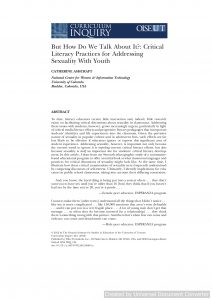Sexuality Education & Therapy with Children
But How Do We Talk About It?: Critical Literacy Practices for Addressing Sexuality With Youth
 Full Article Name: But How Do We Talk About It?: Critical Literacy Practices for Addressing Sexuality With Youth
Full Article Name: But How Do We Talk About It?: Critical Literacy Practices for Addressing Sexuality With Youth
Open Access: No
Abstract
To date, literacy educators receive little instruction and, indeed, little research exists on facilitating critical discussions about sexuality in classrooms. Addressing these issues with students, however, grows increasingly urgent, particularly in light of critical media literacy efforts and progressive literacy pedagogies that incorporate students’ identities and life experiences into the classroom. Given the pervasive nature of sexuality in popular culture and in adolescent lives, such efforts are far less likely to be effective if educators ignore or repress this significant area of student experience. Addressing sexuality, however, is important not only because the current trend to ignore it is impeding current critical literacy efforts, but also because sexuality is itself an important site for students’ critical literacy development. In this article, I draw from my 9‐month ethnographic study of a community‐based educational program to offer an initial look at what classroom languages and practices for critical discussions of sexuality might look like. At the same time, I illustrate how these critical examinations of sexuality were frequently undermined by competing discourses of self‐esteem. Ultimately, I identify implications for educators in public school classrooms, taking into account their differing constraints.
Citation
Ashcraft, C. (2012). But how do we talk about it?: Critical literacy practices for addressing sexuality with youth. Curriculum Inquiry, 42(5), 597-628. https://doi.org/10.1111/j.1467-873X.2012.00610.x
